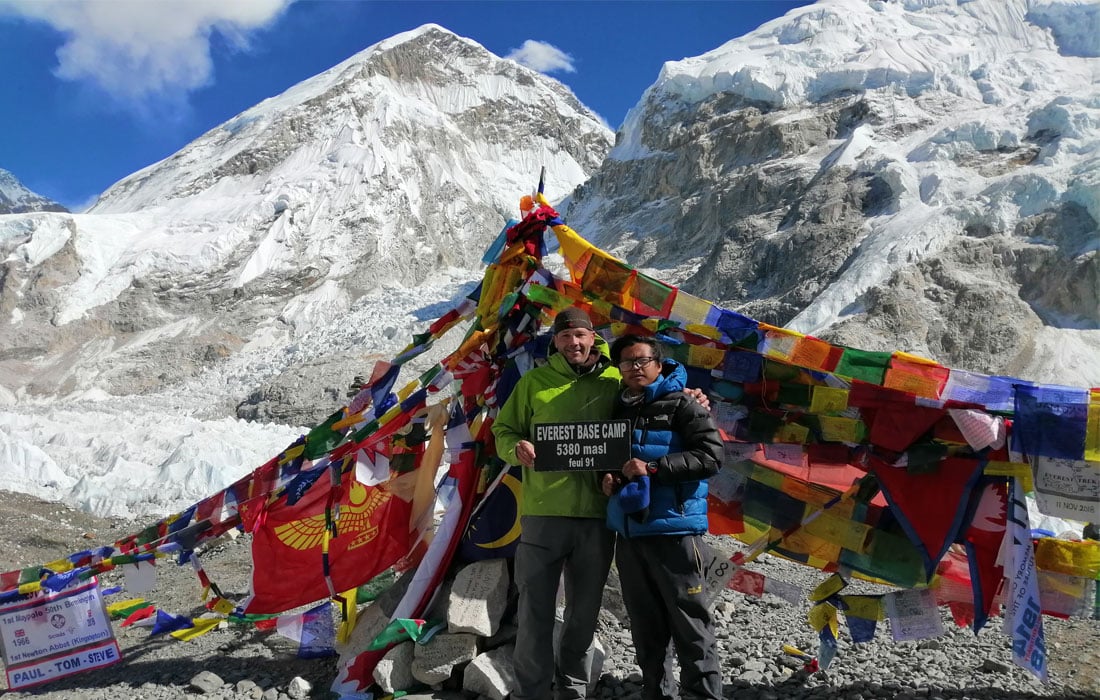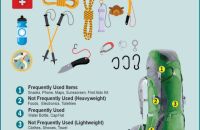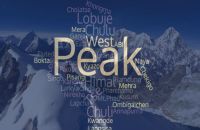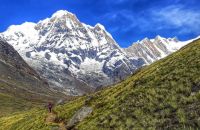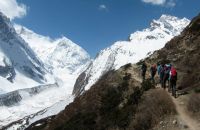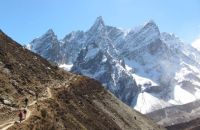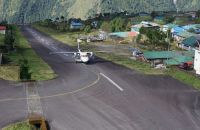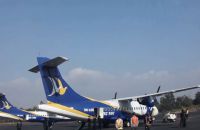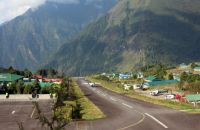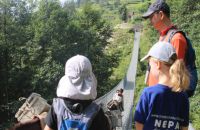Talk with our local travel specialist who can help organize your trip.
How to plan an Everest Base Camp trek in Nepal?
Everest Base Camp trek is an opportunity unlike any other to explore the spellbinding Khumbu region in the laps of the world's tallest mountain, Mt. Everest. The rewards of trekking to the geographically distinct and mesmerizing trek are many. From flora and fauna found in the Sagarmatha National Park to the hospitable Sherpa community and the undeniably panoramic snowcapped mountains, Everest Base Camp Trek has it all.
Are you wondering how to plan the Everest Base camp Trek in Nepal? There are certain things you should consider. In this blog, we will provide you the best tips on the itinerary, routes, best seasons, difficulty, highlights etc. In many of the forums available on the internet, you may not get a satisfying answer to these questions; that is why this blog has been designed to answer the questions.
Table of Content
- Everest Base Camp Trek In Nepal
- Everest Base Camp Trek- What To Expect?
- Prepare Your EBC Trek Itinerary
- Everest Base Camp Trek Major Highlights
- Best Season For Everest Base Camp Trek
- Prepare For The Everest Base Camp Trek Difficulty Level
- How To Avoid Altitude Sickness?
- Training For The Everest Base Camp Trek
- Food And Accommodation In Everest Base Camp Route
- Manage The Everest Base Camp Trek Cost
- Everest Base Camp Trek Permits
- Safety And Security In The Everest Region
- Is It Better To Hire A Trekking Guide?
- Everest Base Camp Trek Packing Checklist
Everest Base Camp Trek In Nepal
Everest is no stranger among the trekking enthusiasts around the world, popularly known as the highest mountain above sea level in the World. At an elevation of 8,848 m/29,029 ft, it is aptly named "Sagarmatha" by the locals in Nepal, which translates to "goddess of the Sky" in Sanskrit. There are many trekking destinations in Nepal's geographically diverse country, but Everest boasts one of the highest inflow of tourists all year round. The thrill, amazement and satisfaction from the Lukla flight to the views from Kala Patthar are unlike any trekking destinations in the world.
While the trek might make you want to hop on the next flight to Nepal, there are certain things you should consider and plans you ought to make. Read ahead to know more on how to plan your Everest Base Camp Trek in the Himalayan country- Nepal.
Recommended Read: Why Is Everest Base Camp Trek Popular?
Everest Base Camp Trek- What To Expect?
Mount Everest sits on the Mahalangur Himal sub-range largely on the northern side of Nepal. Everest Base Camp trek is the most widely known trekking destination in the Everest /Khumbu region. It reaches the elevation of 5,364m/ 17,594ft at the Base Camp but is the second-highest point in the trek, just below, Kala Patthar at 5,550m/18,204ft.
As you enter the Khumbu region, the scene turns back to an olden time. The Sherpa community's lifestyle, who largely inhabit the region, dates back to almost an ancient era. Although modern advancements and the inflow of tourists have changed their ways, they are intact to their culture and traditions. The Everest region's ambiance is only amplified by the hospitable nature of the lovely community residing there. Thanks to their tea houses, hotels, trekking, and climbing support, trekkers from around the globe can enjoy the views of Nepal's glorious mountains.
Apart from the welcoming community, EBC is known primarily for the magnanimous snow-capped mountains. Standing in the lap of Mt. Everest at the Base Camp is overwhelming, but the views from Kala Patthar viewpoint at the elevation of 5,550m/18,204ft is unparallel to any other destination. Panoramic views of mountains like Amadablam, Nuptse, Makalu, Thamserku and Lhotse are among the few that are worth looking at from Kala Patthar.
Amidst the glory of the mountains surrounding the bazaar and village area, the flora and fauna found along the trek stand as a plus point for nature lovers. The Sagarmatha National Park that surrounds the trekking trail is a perfect habitat for animals and birds like Himalayan Monal, Thar, Musk Deer, black bear and more. If you are lucky you might spot these mammals afar, magnifying your trekking experience.
Recommended Read: Top 10 Frequently Asked Questions About Everest Base Camp Trek
Prepare Your EBC Trek Itinerary
There are various routes that you can take for the Everest Base Camp trek. However, while planning the day to day itinerary, it is vital that you analyze the walking distance, average days to travel and compare it with your ability to walk.
If you are not an avid trekker, it is best to take up to 18 days to complete it. However, if you have a good physique and have trekked before, you can complete it in about 14 days.
One of the easier routes begins from a scenic flight to Lukla from Kathmandu. The route then heads to Namche Bazar through Phakding. After acclimatizing and resting at Namche for the next day, the trail leads to Tengboche and Dingboche inhabited by the Sherpa community.
Thereon, you head to Gorak Shep which leads to the highlight of the entire journey, Everest Base Camp. After enjoying the marvelous views from EBC and Kala Patthar, you’ll descend back to Namche from Pheriche. The trek ends at Lukla followed by a flight back to Kathmandu and back home thereon.
Follow the best possible Everest Base Camp trek itinerary for a trek worth remembering. You can also take alternative routes to Everest Base Camp; however, you must keep in mind your physical health, safety and security during the trek so that you don’t fall victim to any sicknesses and extreme fatigue on the way.
Everest Base Camp Trek Major Highlights
EBC trek is a once-in-a-lifetime destination for many. Hence, it is wise to do some research on the Everest region and the route you will follow so that you do not miss out on any of the interesting sites along the way. Following are some of the major highlights of the trek that you can look forward to:
Scenic Flight to Lukla
Even before you enter the Khumbu region, the trip gives you a panoramic appetizer- the scenic flight from Kathmandu to Lukla. Most trekkers remember flying over the green hills towards the snowcapped mountains after the EBC trek. The bird’s eye view of the landscape below and the adventurous landing at the Lukla airport is mind-blowing. The 35 minutes flight is unlike any other flight you will have taken anywhere.
Khumbu Icefall and Glacier
Khumbu Icefall located in the Khumbu Glacier on Everest's slopes is one of the most dangerous yet the most amazing work of nature to be found on the Everest Base Camp trekking trail. The Khumbu Glacier is located in between Lhotse-Nuptse Ridge and Mount Everest and drains into the Lobuche river after melting.
Kala Patthar
Brace yourself for one of the most spectacular views of the Himalayan Range in Nepal. Just above Gorak Shep, to the south lies one of the most talked-about viewpoints in Everest. Luckily, the EBC passes through Kala Patthar where you are offered views of some of the world's top 10 tallest mountains.
Tengboche Monastery
Set your time apart while at Tengboche to enter one of the oldest and largest Buddhist monasteries in the Khumbu region. The ancient paintings, writing, and the monastery's overall vibe give you the golden opportunity to intermingle with the Buddhist tradition and culture.
Best Season For Everest Base Camp Trek
Planning for an Everest Base Camp trek is quite challenging in regards to the harsh and unpredictable weather. Trekking in Nepal's mountainous region means that you will have to be open to the challenging weather. However, the spring season from March to May, followed by the Autumn season from September to November is regarded to be the Best time to go on a trek.
Spring Season: Trekking during the Spring season is characterized by majestic views of the mountain ranges in the clear sky. The temperature can vary from 15 degrees to 20 degrees during the day. Nights and morning are generally colder in the Everest region all-round the year. The national part looks more beautiful than usual with booming flowers. The route is not so slippery due to less snowfall. The weather is predictable and the views are unobstructed.
Autumn Season: Autumn is also regarded to be a wonderful time for trekking in the Everest region or any other trekking region in Nepal. The weather is wonderful with a festive vibe and the sky is are pretty much clear with rainfall only a couple of times during the onset of September.
Even though trekking during Autumn and Spring are known to be ideal in the Everest region, the winner and summer seasons are no less. The Base Camp looks different in different seasons due to snowfall. Due to rainfall in the summer season, there might be a possibility of flight cancellation to and from Lukla. Also, in the winter season from December to February, there might be heavy snowfall, making it slightly difficult to continue on the routes closest to the Base Camp.
All these reasons combined states that Spring and Autumn are best if you are planning the trek. However, you need to be prepared for the high inflow of tourists during these seasons, so preplan your accommodation.
Recommended Read: Everest Base Camp Trek In October
Prepare For The Everest Base Camp Trek Difficulty Level
While you are planning for one of the most exciting trips of your lifetime, it is wise to keep in mind the difficulty level of Everest Base Camp. Characterized as a moderate to difficult level trek, the trek covers a distance of 130 km on the round trip in totality. In comparison to many of the trekking destinations in the Khumbu region, the distance and difficulty of the trek are certainly moderate to difficult at best. However, the route is relatively easier than other treks like Gokyo Lakes Gokyo Ri Renjo La Pass Trek- 14 days and Everest Three High Passes Trek- 20 days.
On average, the walking hours per day totals to about 7 to 8 hours. Also, walking quickly might adversely affect the trekkers by causing altitude sickness. Difficulties might even arise from the unavailability of preferred accommodation or food. Due to the rugged topography of the Khumbu region, sharp ascends and descends are faced on the route.
All difficulties considered, a tailor-made itinerary and a well-planned trek can make the trekking enjoyable and less straining. Also, taking the Everest Base Camp Trek map along with you during the trek will help map out the routes. The EBC trail is not a difficult one and can be thoroughly enjoyed. Walking with a local guide might be another way to ease away the difficulties of finding accommodation.
How To Avoid Altitude Sickness?
Altitude Sickness is regarded as one of the leading causes of mortality in the trekking trail that goes past 3000 meters. Preparing for the EBC Trek means that you have to prepare yourself for even the slightest possibility of Altitude Sickness or Acute Mountain Sickness (AMS). To avoid getting AMS, you need to be aware of its symptoms. While dizziness, headache is some of the common symptoms, nose bleeding, vomiting and fever are more severe symptoms.
Prevention is most certainly better than cure, which is why rushing to the Base Camp before the day arranged in the itinerary can prove to be harmful. As mentioned in the itinerary- Namche Bazar and Gorak Shep are vital to acclimatize your body to the sudden change in altitude. The sudden change in altitude will adversely affect your respiration and the amount of oxygen reaching your bloodstream. Apart from following the itinerary, you can also take the prescribed dosage of medication to avoid AMS. You can visit the local physician or your doctor to take advice on the matter before you head for the trek.
Training For The Everest Base Camp Trek
A person with a fit physique can complete the trek on the provided time with ease. For those trekkers who are not accustomed to this level of trekking, it is vital that you indulge in some exercise, swimming, cycling, jogging, or running to flex your muscles and keep yourself fit.
Smokers are also advised to reduce or quit smoking a couple of weeks before the trek as you would want your lungs to function well in higher altitudes. Many experts also advise going on a few short hikes in nearby areas to be accustomed to walking since you will have to walk an average of 7-8 hours per day on the trek. Training your body is very essential for a moderate to difficult level trek. It helps you to stay healthy and prepared and enjoy the trek at the fullest.
Food And Accommodation In Everest Base Camp Route
Unlike the 1980s and 1990, it has become quite easy to find food and accommodation along the way in the Everest Base Camp Route in recent years. Due to the attraction of tourists, many advancements have been seen in EBC. Tea Houses can be found all along the way at a distance of two or three hours. You can find decent meals along the way.
In some hotels and tea houses, you can even find Western dishes. However, due to the difficulty in transporting the goods, the food is costlier as you head to higher elevation and harsher topography. A decent staple diet of Nepalese; Dal (lentil), Bhat(rice) and Tarkari (vegetables) can be easily found in every tea house and is a carbohydrate-rich diet- just what you need after a long trek.
If you wish to save money then you can carry along a few packaged foods. Trekkers are often seen carrying instant noodles and making hot soups. It is advised to carry carbohydrate-rich food along with while trekking. Chocolates, dry fruits, cookies and a bottle of water should be carried each day during treks. Hot drinks like black tea and coffee are found in the tea houses. It is better if you bring refillable water bottles with a water filter since the mineral water bottles cost heavily at a higher altitude.
Accommodation is mostly done on a sharing basis which is better for all trekkers. On a sharing basis, the one-night rent is relatively cheap. During the off-seasons, accommodation is much cheaper. Tea Houses can be really helpful to leave your heavy bags if you are to hike from Gorak Shep to EBC and return back for an overnight stay.
Manage The Everest Base Camp Trek Cost
Everest Base Camp Trek is not costlier ass other treks in the Everest region. Your cost management in the EBC trek depends largely on how much you wish to spend and how you wish to spend it. If travel agencies in Nepal arrange your travel then it will cost you below $2000, on average, excluding the travel fare to and from Nepal and extra luxury costs. However, the cost may differ according to the season you wish to travel and the number of days you want the itinerary to be prepared.
If you are traveling on your own, then there are many costs that you will have to consider including travel, accommodation, food, permits and more. Hence, to make it easier, it is best if you take the support of a travel agency to set up your travel plan in a foreign country.
Everest Base Camp Trek Permits
There is a need to carry certain documents along with yourself if you wish to travel to Nepal. The documents include your passport, your passport-sized photos and Nepali Tourism Visa. Planning a trek in EBC on your own can be quite hectic, so it is best advised to contact a Travel Agency in Nepal. A good travel agency will help you sort your documents and collect the trek permits for you.
The permits required for trek are
- Khumbu Pasang Lhamu Rural Municipality Entrance Permit: This permit should be shown at the entrance of the Khumbu region. The permit costs around $20 per person.
- Sagarmatha National Park Entry Permit: Since Everest Base Camp is located inside the Sagarmatha National park so this permit is required. It will cost anywhere from $30 to $15 for an individual depending on their nationality.
The permits mentioned above are applicable to Non-Nepali tourists. It is easier to coordinate with your travel agents who will get you the permit without hassle in the trek package.
Safety And Security In The Everest Region
Everest region is a popular trekking destination so there are fewer security issues. Nepal in the most recent years has seen advancements in the Everest trekking trail. The routes are mostly filled with tourists so it is less likely that you might lose the way. However, it is always a wiser option to hire a guide if you are a tourist in Nepal.
Is It Better To Hire A Trekking Guide?
Security and safety are not the only things that would promote the hiring of a trekking guide but there are numerous reasons why it would be good:
With a guide along you get to explore the culture, history and traditions of the community living in the Everest region which you would most likely not do alone. Guides have better experience and expertise on these trekking destinations.
Guides can assist you to communicate with the locals since many local guides know their language. One of the best experiences in the trek is to talk with the local people and hear their stories, folklore, incidents and interesting facts about the Everest region.
It is relatively easier to find accommodation and food on the trekking trail if you have a guide along since they know the best places and they have networks in the tea houses along the route.
Furthermore, if you want to travel without the hassle of carrying your heavy backpacks and trekking gear, then you might as well hire a porter to do so. A porter is allowed to carry no more than 25 kgs weight. Although this is entirely optional, hiring a porter might make it easier for you to trek and help society with employment.
Everest Base Camp Trek Packing Checklist
EBC is one of the trekking destinations that fall at a high altitude, hence it is essential to carry all the necessary packing list (essentials) to avoid falling victim to the cold and harsh weather and landscape. Some of the essentials are mentioned below:
- Clothing: Needless to say, warm clothing helps the body to get insulated at a higher altitude.
- Woolen Caps, gloves, and socks
- Raincoats, windcheater, flannels
- Fleece jackets
- Earmuffs, mufflers
- Down jacket
- Cotton and woolen innerwear and trousers
- Trekking Gears: Trekking gears can be bought from trekking stores in Thamel upon reaching Kathmandu.
- Walking poles
- Headlamp
- Camera kits
- Large backpack
- Accessories
- hiking shoes/ trekking boots
- Sunglasses (protect eyes from snow blindness)
- Solar-powered batteries
- Swiss Knife
- Hygiene products
- Tissue rolls
- SPF sunscreen for UV protection
- Moisturizer, lip balm
- Toiletries (toothbrush, shampoos, oils, soaps, insect repellent)
- Other personal items
- Medication
- First aid kit
- Antiseptic lotion
- Blister plasters
- Bandages
- Digestive syrups
- Altitude sickness medication (Acetazolamide)
In essence, the Everest Base Camp trek is one of Nepal's most wonderful treks that introduces you to the beautiful Khumbu region, home to the tallest mountain in the world. If you plan to hop on the next flight to the Everest region or are planning it for the near future, you need to consider various aspects, including itinerary, difficulty level, packing checklist, food, accommodation, permits, and more.
A well-planned trek is always one of the most interesting treks. Hence, if you wish to travel to the north of Nepal with hopes of stepping on the lap of Mt. Everest then the Everest Base Camp Trek is the ideal trek for you. With experienced staff and the customer’s satisfaction and happiness in mind, Third Rock Adventures has been the reliable partner for many trekkers in their Everest Base Camp trek.
If you wish to inquire about any more details or booking for the Everest Base Camp Trek, please feel free to contact us. Join in for the adventure of your lifetime with us in the foothills of Everest.
- Written by: Naba Raj Amgai
- Updated: Tuesday Feb 2, 2021

